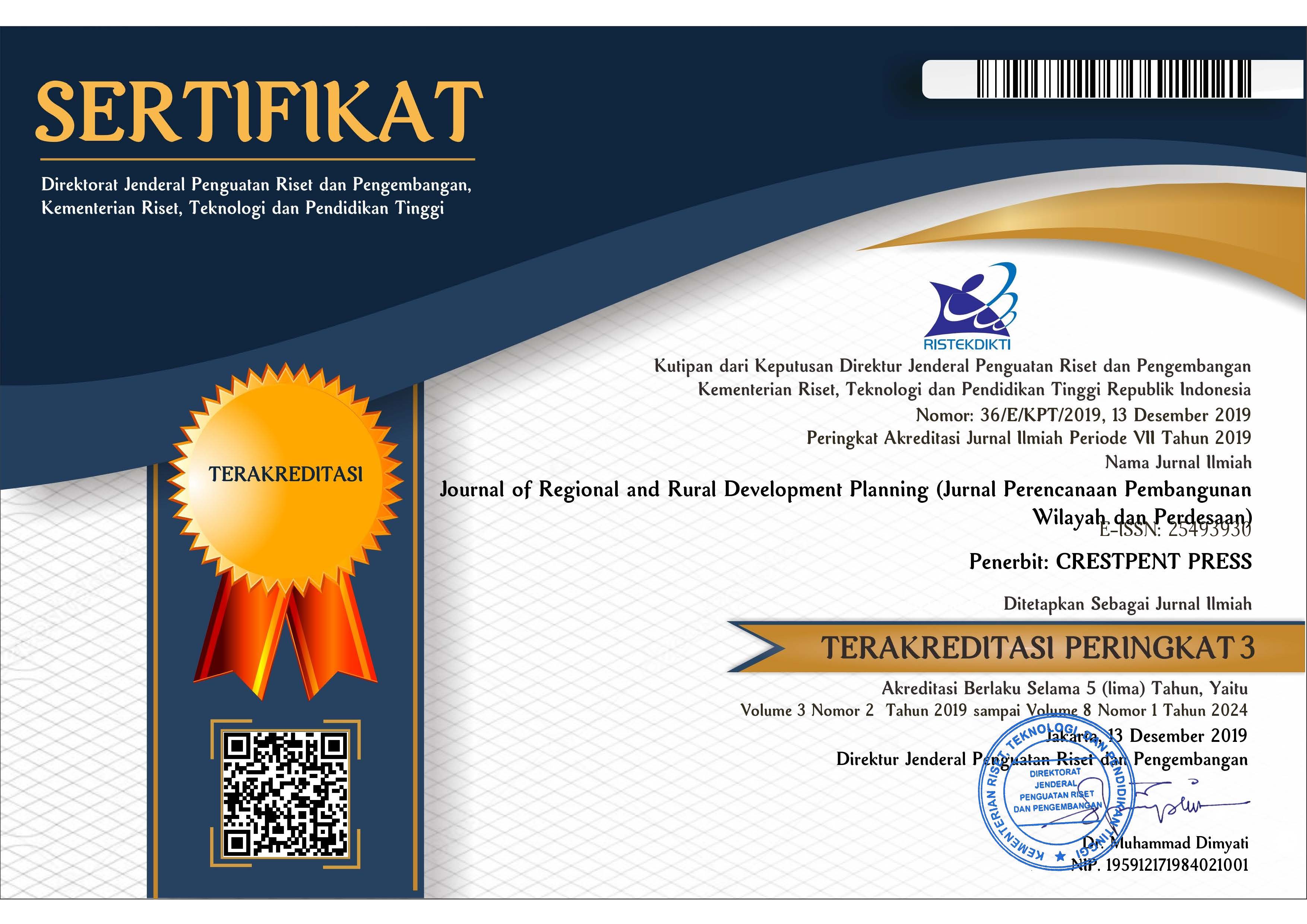Strategi Adaptasi: Kisah Desa Kawa dan Desa Morodemak dalam Menghadapi Perubahan Populasi dan Ekologi
Abstract
Population growth in coastal areas, especially as a result of migration, has put pressure on the environment, both the built environment and the community management environment in implementing sustainable livelihood strategies. This paper wishes to explain two models of community adaptation in two distinct areas, namely Morodemak Village on the north coast of Central Java, which began to recede in the management of common resources, and Kawa Village in Seram Barat coast, which is still strong in maintaining the tradition of coastal and terrestrial territorial management as a common resource. The research methodology used in this research is qualitative approach, with semi structured interview and focus group discussion. From the results of the study, it was revealed that people were able to reshape their resources based on ecological and social changes, as their adaptation strategy in sustaining sustainable livelihoods.References
Adhuri, D. S, Rachmawati, L., Sofyanto, H. & Hamilton-Hart, N. (2016). Green market for small people: Markets and opportunities for upgrading in small-scale fisheries in Indonesia. Marine Policy 63(2016), 198–205
Alland Jr, A. (1975). Adaptation. Annual Review of Anthropology 4(1975), 59-73.
Ashley, C. & Carney, D. (1999). Sustainable Livelihoods: Lessons from Early Experience. London: DFID
Colin-Castillo, S. & Woodward, R. T. (2015). Measuring the potential for self-governance: an approach for the community-based management of the common-pool resources. International Journal of the Commons 9(1), 281–305
DFID. (2001). DFID Sustainable Livelihoods Guidance Sheets. www.ennonline.net/ dfidsustainableliving
Ellis, F. (2000). Rural Livelihoods and Diversity in Developing Countries. Oxford: Oxford University Press
Fabinyi, M. (2018). Environmental fixes and historical trajectories of marine resource use in Southeast Asia. Geoforum 91 (2018), 87-96
Fischer, A. P. (2018). Pathways of adaptation to external stressors in coastal natural-resource-dependent communities: Implications for climate change. World Development, in press
Hardesty, D. L. (1977). Ecological Anthropology. New York: Mc Graw-Hill.
Harvey, D. (1989). The Condition of Postmodernity. London: SAGE Publications Ltd.
Harvey, D. 2010. Imperialisme Baru: Geneologi dan Logika Kapitalisme Kontemporer. Yogyakarta: Resist Book
Haryono, T. J. S. (2005). Strategi Kelangsungan Hidup Nelayan: Studi tentang diversifikasi pekerjaan keluarga nelayan sebagai salah satu strategi dalam mempertahankan kelangsungan hidup Berkala Ilmiah Kependudukan. 7(2), 119-128
Kanas, A., Scheepers, P. & Sterkens, C. (2017). Positive and negative contact and attitudes towards the religious out-group: Testing the contact hypothesis in conflict and non-conflict regions of Indonesia and the Philippines. Social Science Research 63 (2017), 95-110
Kementerian Perikanan dan Kelautan RI. (2016). Laporan Akhir Penyusunan Data Dasar Program Sekaya Maritim dan Pengembangan Model Permukiman di 10 Lokasi Prioritas
Kusnadi. (2009). Keberdayaan Nelayan dan Dinamika Ekonomi Pesisir. Yogyakarta: Arruz Media
Kusnadi. (2000). Nelayan: Strategi Adaptasi dan Jaringan Sosial. Bandung: Humaniora
Utama Press
McCarthy, J. J., Canziani, O. F., Leary, N. A., Dokken, D. J., & White, K. S. (Eds.). (2001). Climate Change 2001: Impacts, Adaptation, and Vulnerability. Cambridge: Cambridge University Press
Magis, K. (2010). Community resilience: an indicator of social sustainability. Society & Natural Resources 23(5), 401–416
Mujio, Adrianto, L., Soewardi, K. & Wardiatno, Y. (2016). Analisis potensi konflik pemanfaatan ruang kawasan pesisir: integrasi rencana tata ruang darat dan perairan pesisir. Sodality: Jurnal Sosiologi Pedesaan, Agustus (2016), 139-144.
Nurcahyanti, E. E., Surjono, & Kurniawan, E. B. (2010). Penataan Permukiman Nelayan Puger Ditinjau Dari Aspek Kekumuhan dalam Jurnal Tata Kota dan Daerah, 2(2), 41-48.
Ostrom, E., Gardner, R., & Walker, J. (1994). Rules, Games, and Common-Pool Resources. The University of Michigan Press
Ostrom, E. (2009). A general framework for analyzing sustainability of social ecological systems. Science 325(5939), 419–422
Sahlins, M. D. (1968). Culture and Environment: The Study of Cultural Ecology. Theory in Anthropology A Sourcebook. R. Manners & D. Kaplan (Eds.) Chicago: Aldine.
Setiawan, W. & Barrett, P. S. (2016). The built environment element of economic development in post conflict response in Indonesia. Procedia - Social and Behavioral Sciences 234 (2016), 478-487
Scoones, I. (1998). Sustainable Rural Liveihoods A Framework for Analysis. IDS Working Paper 72. Institute of Development Studies
Wakano, A. (2009). Dampak konflik Maluku: studi konflik dan kekisruhan pada pengungsi Iha, Kayu Tiga dan, Seriholo. Agama dan Pergeseran Representasi : Konflik dan Rekonsiliasi di Indonesia. Jakarta: Penerbit Wahid Institute
Copyright (c) 2018 Journal of Regional and Rural Development Planning

This work is licensed under a Creative Commons Attribution-ShareAlike 4.0 International License.




.png)














